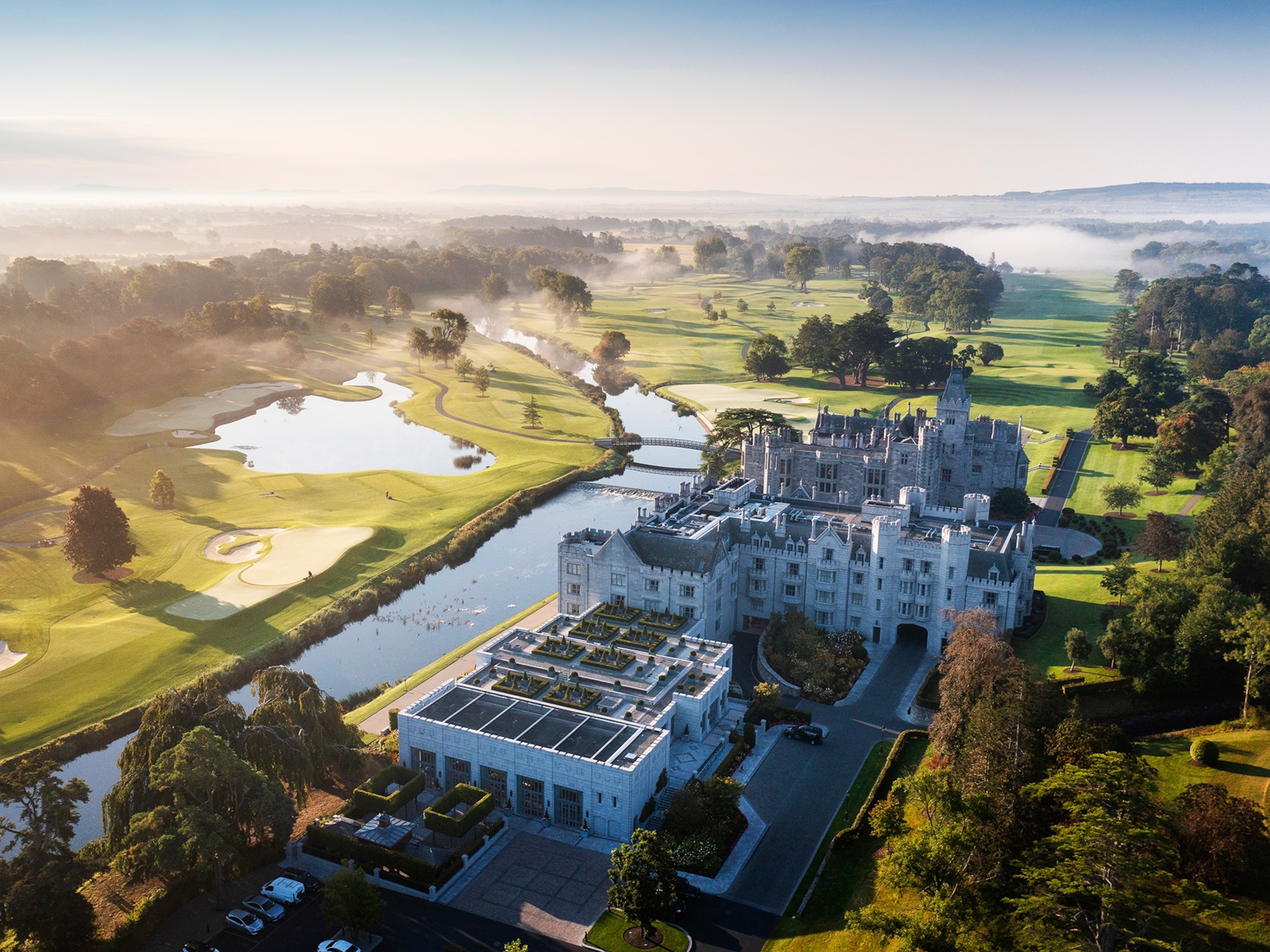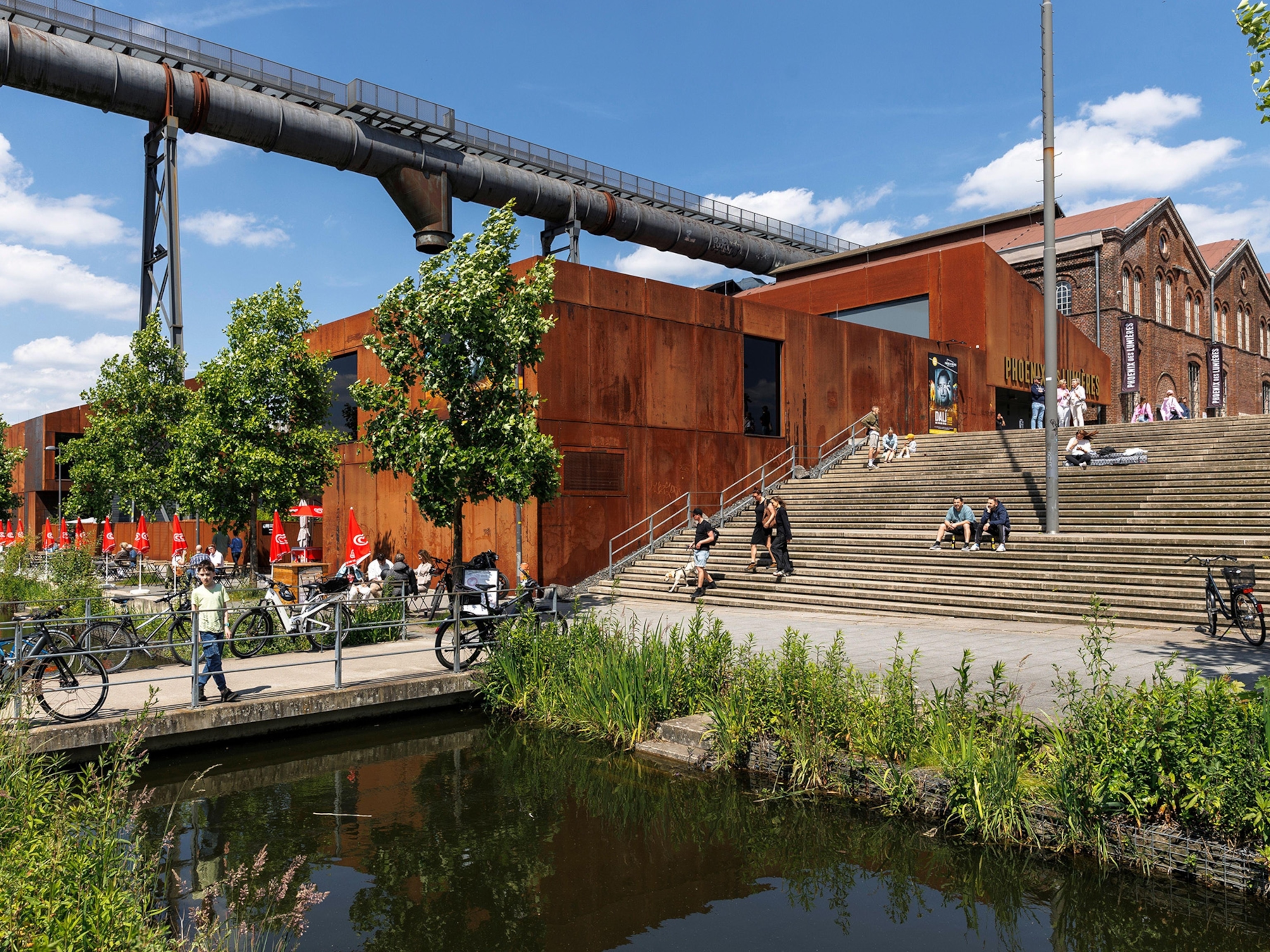
Top Ten Things to Do in Ireland and Northern Ireland
Epic coastal drives. Historic links courses. Literary pub tours. Castles that echo of ancestry. The allure of Ireland and Northern Ireland is as strong as ever—soak it all in with these ten don't-miss experiences.
Fly Falcons at Dromoland Castle
Falconry was a sport of choice among medieval nobility, so it makes sense for Dromoland Castle to offer a School of Falconry—it’s the ancestral home of the O’Briens, descendants of Brian Boru, High King of Ireland in the 11th century. On this private experience with falconer and hawk, you walk through the wooded castle demesne, launching a trained hawk skyward and calling it back to your gloved fist as the chieftains did back in the day.
There has been a castle here for a thousand years that was rebuilt several times; the last major renovations turned it into a luxury hotel that opened in 1963. Here chivalry is not forgotten (there’s even a suit of armor in the entry hall); dinners are multi-course feasts with paired wines and resident harpist; and the attentive service is kingly. Suites are large and comfortable; some are located in the castle’s turrets. Falconry is just one of the estate pursuits, which also include pony and trap rides, clay pigeon shooting, fishing, horse riding lessons, and a par-72, Ron Kirby-designed golf course.
Drive the Wild Atlantic Way
This new touring route takes in the entire western seacoast of Ireland, offering stunning vistas, a rugged coastline, charming villages, tearooms, pubs, ancient ruined castles, and photo ops. The Wild Atlantic Way is reportedly the longest defined coastal drive in the world. It covers over 1,500 miles, from Inishowen Peninsula, County Donegal, in the north to Kinsale, County Cork, in the south, with many additional loops and diversions. The route is signposted and features more than 150 "Discovery Points," such as the 1,972-foot-high sea cliffs of Slieve League in Donegal that are nearly three times as high as the Cliffs of Moher, and Mizen Head Signal Station on Ireland’s most southwesterly point. Included are opportunities to experience Ireland's heritage, perhaps at Limerick’s King John’s Castle; taste local delicacies like Galway oysters; head out on an adventure, such as surfing Bundoran in County Donegal; and take in music at events like the Willie Clancy Festival in Milltown Malbay, County Clare. It’s far more than a driving route.
Try a True Links Course
One third of the world’s seaside links courses (more than 50) ring the coastline of Ireland, where golfers are spoiled for choice. Links courses—one of the first types of golf courses—are notoriously tricky. Golfers have to thread the ball through sand dunes that can reach 200 feet high and hit tiny greens topping sea grass-tufted dunes, while dealing with wind currents and changeable weather.
Topping the list of links courses is Northern Ireland’s Royal Portrush Golf Club, established in 1888, home course of Darren Clarke, winner of the 2011 British Open, and Graeme McDowell, winner of the 2010 U.S. Open. Ballybunion Golf Club in County Kerry, established in 1893, is former U.S. President Bill Clinton’s favorite (there’s a statue in town of him swinging an iron) and the Old Course was included in Golf Magazine’s top 20 courses of the world in 2011. Waterville Golf Links on the Ring of Kerry is Tiger Woods’s Ireland favorite—he has played it to prepare for the British Open, which he won three times as part of his 14 major championship wins. Paul McGinley, European team captain for the 2014 Ryder Cup, chooses his home course County Louth Golf Club, known as “Baltray,” north of Dublin as his favorite. There are some 400 additional golf courses in Ireland, and best of all, anyone can play them regardless of handicap or connections.
Sample Cork’s Artisanal Food
The English Market in Cork’s city center is a roofed food emporium showcasing regional Irish ingredients and artisanal food offerings. It’s also a destination for shopping, noshing, lunching, and people-watching (Queen Elizabeth II visited in 2011). Established in 1788, it originally helped provision fleets in the harbor, and through years of economic hardship, the famine, the Irish War of Independence, and the Civil War, the English Market kept its doors open. When the economy improved in the 1990s, a new food culture influenced by Europe got under way based around naturally and locally produced food with the English Market at the epicenter. Here craft butchers offer free-range duck, organic chicken, and traditional black pudding; fishmongers sell wild-caught fish from nearby Castletownbere; and growers display gooseberries and blackberries. There are artisanal producers of goat’s cheese, soda bread, charcuterie, chutney, chocolate, and cakes. The Farmgate Café on the upstairs balcony features some of the market’s best: potato and wild garlic soup, St. Tola goat’s cheese salad, corned beef, bread-and-butter pudding. It’s sustenance with a story.
Toast Literary Dublin
Many literary figures have called Dublin home, and all had a favorite pub where they spent a great deal of non-writing time. On the Dublin Literary Pub Crawl, two actors perform prose, poetry, and theatrical scenes by writers affiliated with four historic pubs. It’s a fun rollick around the city, mixing literary entertainment with liquid libation.
The crawl starts at The Duke, founded in 1822, which Patrick Kavanagh frequented, then moves on to O’Neill’s, a favorite of Brendan Behan. Revolutionary leader Michael Collins drank at The Old Stand, and James Joyce drank at Davy Byrnes as a student, later setting an episode in Ulysses in the pub in which Leopold Bloom has a Gorgonzola sandwich and a glass of Burgundy. In this UNESCO City of Literature, visitors can also take in the Dublin Writers Museum and the James Joyce Centre; take part in Bloomsday (June 16) festivities that follow events in Joyce’s Ulysses; visit Oscar Wilde’s statue reclining on a boulder in Merrion Square; and attend the Dublin Writers Festival in May to catch up with current authors.
Learn About the 'Titanic'
When the supposedly unsinkable R.M.S. Titanic hit an iceberg and sank with a loss of over 1,500 lives in 1912, it began a fascination that endures over a century later. For the 2012 centennial, Titanic Belfast in Northern Ireland opened with an acclaimed design in the place where the ill-fated liner was built. The museum is an interactive experience that takes you on a high-speed thrill ride through the shipyard, shows what it took to build the Titanic, tells the stories of some of the passengers, shows the media coverage of the sinking, explores the wreck beneath a glass floor, and explains the underwater exploration.
In Belfast’s Titanic Quarter, you can also tour the ship’s dry dock and pumphouse; board the Titanic’s opulent first-class tender, the recently restored S.S. Nomadic; take a walking tour of the Harland & Wolff shipyard, drawing office, and more; or take a harbor cruise to see the slipways and structures from the water.
Go on an Epic Pilgrimage
Croagh Patrick in County Mayo is Ireland’s holy mountain and the 1,500-year-old Christian pilgrimage tradition continues to this day—each year thousands of pilgrims visit this forbidding, 2,510-foot-high mountain. The mountain was already a place of pagan worship for the harvest festival of Lughnasa when St. Patrick arrived in the year 441 and supposedly fasted for 40 days at the top, banishing the snakes from Ireland during his stay. Rent a walking stick at the base for this tough climb over stony terrain, and consider yourself blessed if you can see the view from the top over Clew Bay. Don’t try to climb it on Reek Sunday, the last Sunday in July, as 20,000 people attempt it that day. For the full experience, start your pilgrimage at Ballintubber Abbey, near the spot where St. Patrick reportedly baptized converts. Pilgrims put to use an ancient chariot route running from the seat of the Connacht kings to Croagh Patrick, and the 22-mile path became known as St. Patrick’s Causeway.
Marvel at Manuscripts
The illuminated manuscripts produced by monks in the great monasteries primarily from the seventh to ninth centuries are intricate works of art with decorative Celtic knotwork and depictions of animals and saints. They are Ireland’s masterpieces, and their ornamentation is unique in the world. The Treasury and the “Turning Darkness Into Light” exhibition at Trinity College Dublin present a number of ornate manuscripts, such as the Book of Armagh, the Book of Mulling, and the Book of Dimma.
The highlight is the Book of Kells, considered by many the most beautiful book ever created. The Book of Durrow is a century older than the Book of Kells and is the oldest complete illuminated gospel in existence. The museum explains how the manuscripts were produced and the quirks of some of the scribes, including mistakes they made and inside jokes they worked into the designs. Upstairs, the Long Room is among the most inspiring libraries in the world, with soaring tiers of 200,000 rare books and rows of white marble busts of Western philosophers and writers such as Plato, Socrates, Aristotle, and Swift.
Explore Dingle
Before the Age of Discovery, Europeans believed Dingle Peninsula—the most westerly point in Europe—to be the edge of the known world. The area has the greatest concentration of ancient monuments in Ireland, and stunning scenery to boot. The 25-mile drive around the coast is packed with ancient sites, walking trails, museums, and photo ops.
There are standing stones, beehive huts, the sixth-century Riasc monastic settlement, a promontory fort topped with an ogham stone, and views of the Blasket Islands from Slea Head. The Blasket Centre explains the islands’ way of life and literary legacy. Gallarus Oratory is a fine example of dry-stone masonry; it’s shaped somewhat like an upside-down boat and is in near perfect condition some 1,300 years after construction. At Kilmalkedar Church, you’re guaranteed a spot in heaven if you climb through the narrow window three times, according to local folklore.
Dingle town is bustling with an aquarium, seal sanctuary, boat trips to the Blaskets, and art galleries. It offers excellent seafood restaurants and traditional music sessions in the pubs, too.
Get Active in Killarney National Park
After Queen Victoria’s visit to Killarney in 1861, the charming town became Ireland’s first tourist destination, and it still holds the top honor with good reason—it has Killarney National Park on its doorstep. It’s the largest national park in the country and offers stunning scenery, historic sites, and interesting things to do, with more active options than sitting in a car or bus around the Ring of Kerry.
Walk the trails around the Lakes of Killarney backed by Macgillycuddy’s Reeks, the country's highest mountain range, stopping for tea at Dinis Cottage near the Meeting of the Waters. Tour the Victorian Muckross House and Gardens, or the 15th-century Ross Castle on the edge of the lake. Take a jaunting car through the park entertained by the jarvey (driver), or ride a horse from Killarney Riding Stables. Take the boat to Innisfallen Island, where High King Brian Boru purportedly was educated at the seventh-century monastery. Hike to Torc Waterfall, poke around ruined Muckross Abbey, or take in the lake vista from Ladies View.
- National Geographic Expeditions





